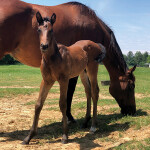It’s that time of year again. The rain, green leaves on the trees, and shedding horses are all signs spring has arrived. As you prepare your equine for warmer weather and more riding, showing your pasture a little spring TLC can go a long way as it pertains to the health of your horse.
Dr. Wayne Conley, owner of Willow Oak Farm in Rosemark, Tenn., suggests starting spring pasture prep with these simple tasks: observe and inspect. He suggests taking a “slow walk around all pastures.” Not only does this allow you to check for downed limbs, fences that need fixing, and anything unusual in your pasture (Dr. Conley has found a flashlight, shed deer antlers that could pop a tractor tire, and various other objects), but a slow, methodical walk also allows you to notice any bare spots in the pasture. These bare spots among the grasses raise the questions: “What’s not growing here? Why?”
If grass is not growing consistently, you may want to submit a soil sample to determine the health of your pasture. According to Chris Cooper, PhD, and Kyla Szemplinski, MS, of the UT-TSU Shelby County Extension Office, “Good soil is the foundation for any pasture,” literally. A soil test reveals the soil’s pH (ideal pH is 5.5-7.0) and any fertilizer needs as well. Testing the soil is imperative, as it is the only determinant of critical nutrient and mineral replacement, if needed. Contact your local UT Extension office for further information on taking and submitting a soil sample.
One perennial problem most horse owners face each spring is weed management. We all know weeds compete with good grasses, so it’s important to remove them. When it comes to controlling weeds in your pasture this spring, there are organic alternatives to spraying herbicides: mowing and rotational grazing.
If you choose to mow for weed control, Dr. Conley advises you not to mow below two to three inches. Anything lower than that can easily introduce parasites to your equine. Mowing is beneficial in both pasture management and weed control in that it “encourages grazing and stimulates root and plant growth,” Kyla states.
Rotational grazing prevents overgrazing, which allows weeds to flourish. Kyla recommends dividing your pasture into segments and rotating your horses through these segments once it has been grazed down to 4-5”. Not only does rotational grazing decrease the amount of spring weeds, it can also decrease the effects of erosion, amount of hay you feed, and maintenance fertilization. If possible, Kyla suggests housing horses on a dry lot or sacrifice lot when pasture grasses are re-growing.
Parasites can be controlled through proper spring pasture prep as well. A manure management protocol can reduce parasite load in the ground. This can be as simple as physically removing manure off small pastures or dragging larger pastures. Dragging exposes the parasites found in manure to the environment, thus killing them. For those horse owners with larger pastures, plan to drag 2-3 times a year during hot, dry weather.
Having a plan in place to combat erosion is another important aspect of spring pasture preparation. With all the recent spring rain, most pastures tend to become muddy. Smaller pastures and those with high traffic areas “become victims to erosion faster, thus turning into mud fields,” UT Extension Agent I, Kyla, states. Not only does mud become a breeding ground for parasites, which can cause painful hoof abscess and other equine hoof ailments, but it is a safety hazard for both the equine and equestrian as well. She recommends horse owners with extensive spring mud “invest in a high traffic pad with geotextile fabric in areas such as dry lots, feeding areas, gates, shelters, etc.” If a larger pasture is in a geographic area of highly erodible land (HEL) and preventing mud before spring has a chance to create it is the goal, Dr. Conley suggests keeping your soil covered, and therefore, protected with a cover crop. He also states you can create a buffer by fencing off the area in between the pasture and the area at risk for erosion.
Finally, it wouldn’t be spring if we didn’t discuss the laminitis risk the lush, sugary spring grass brings with it. According to Dr. Cooper and Kyla, these lush pasture grasses contain “tons” of non-structural carbohydrates (NSC), which are, essentially, sugars (such as fructan) and starches. As stated in the article, “Spring Pasture Turnout, the Safe Way,” by Michele Harn, M.S., these NSC can upset the horse’s gut and trigger laminitis and potential colic episodes as well. “It is critical to slowly introduce horses to lush pastures in timed increments,” Kyla states. Try grazing only 15 minutes per day at first, gradually increasing until you reach target turnout time. Studies suggest NSC are lowest in the early morning hours of 4AM-8AM. If you have a horse with previous metabolic or laminitis issues, keep in mind spring grasses are highest in NSC, Dr. Cooper advises. He also suggests supplementing these susceptible horses with hay low in NSC, such as warm-season grasses, like bermuda, and, again, restricting turnout time.
A little planning and preparation this spring can set your equine up for good grazing as we enter the warmer months.










